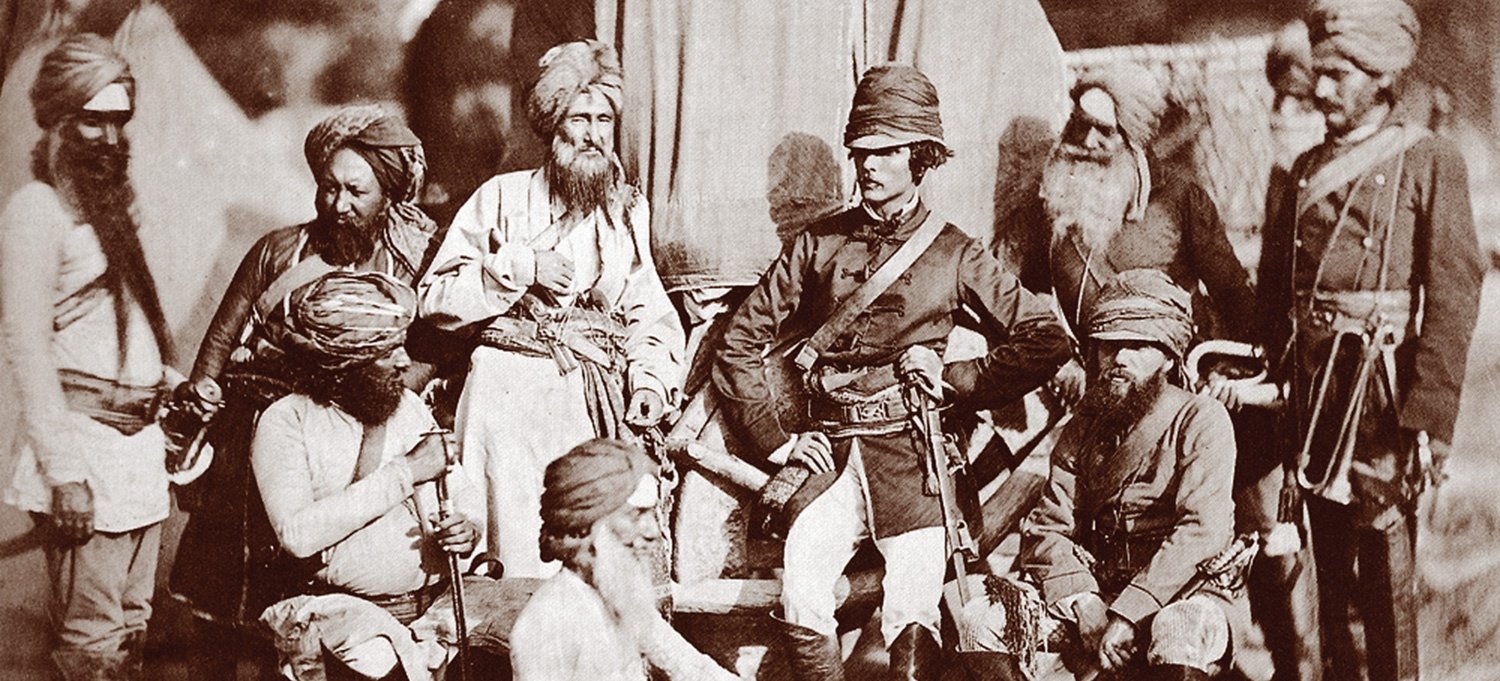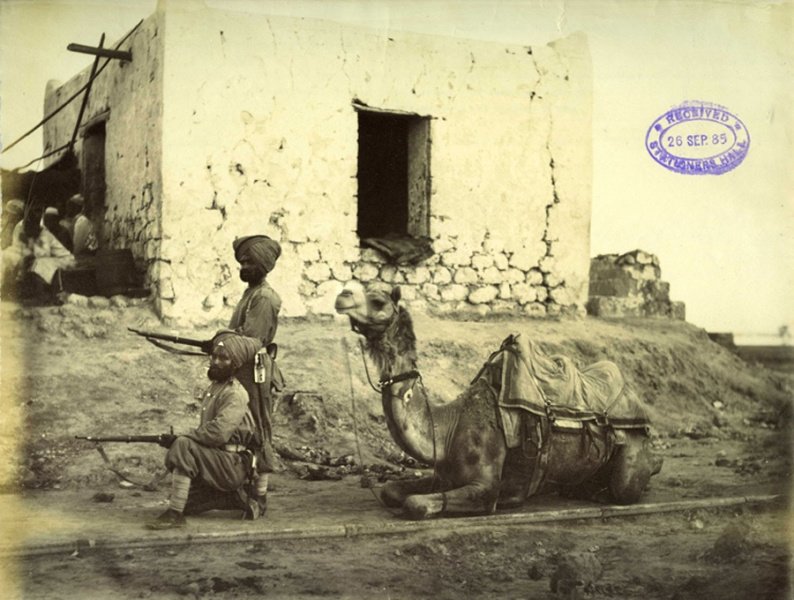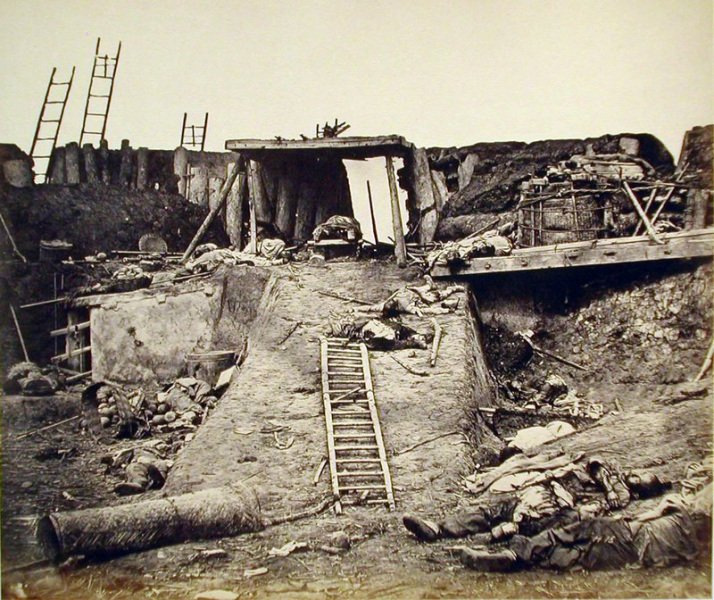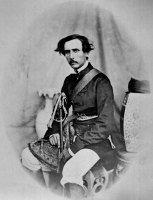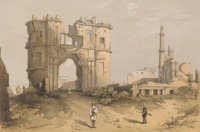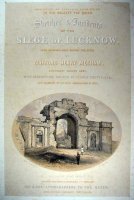I don’t know why I shooted these two pictures from the album “Indian Historical Photography”. The Book Café, opened on the outskirts of McLeod Ganj in the Himalayas by a cheerful little Belgian, is full of excellent albums, and they contain beautiful photographs. The most important thing in this story is that I did not shoot the photo captions. Then he realized: what are they depicted?
Well, let’s say the first one – with skeletons in some square – fascinated by an incredible apocalyptic plot, more like Vereshchagin’s painting than a real photo. But the second one seemed much more banal: a certain warrior (most likely an Englishman) flaunts in front of the camera surrounded by exotic Indians. There was no connection between the pictures.
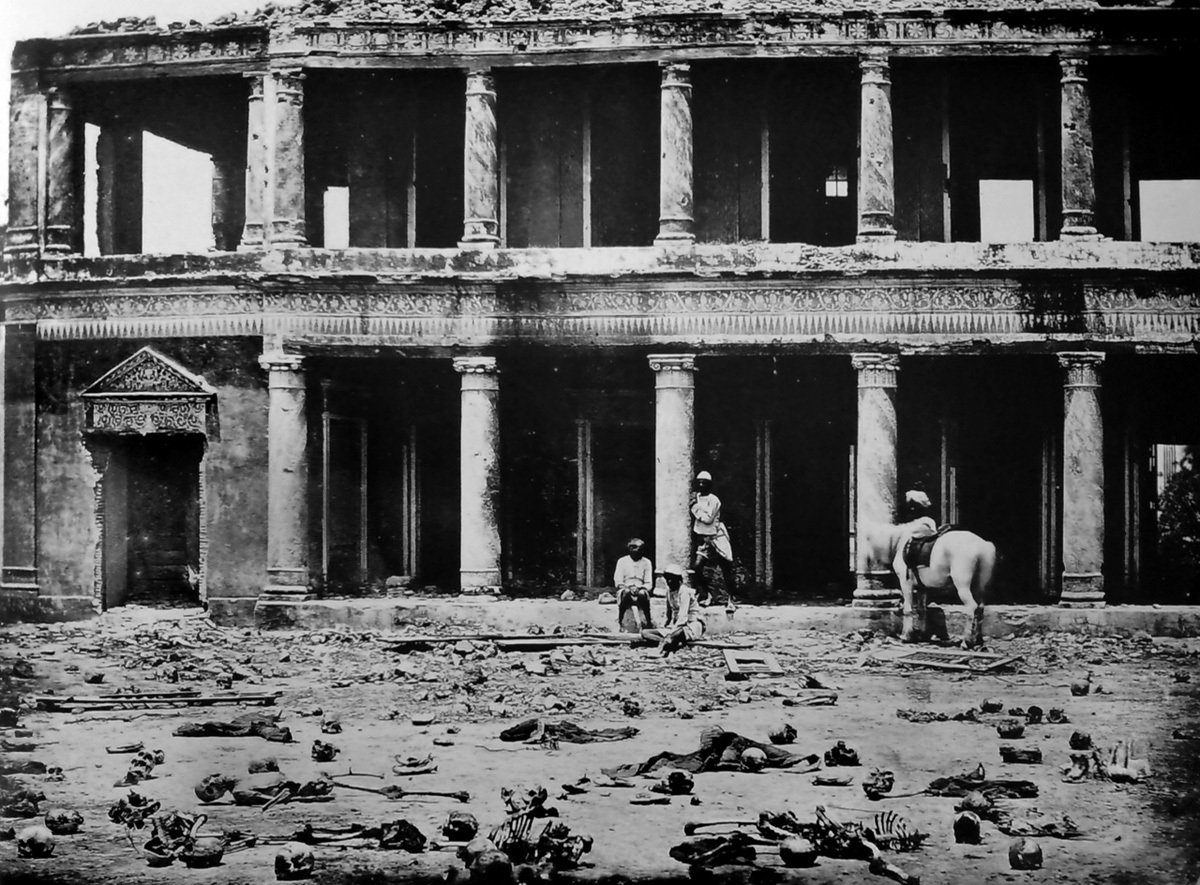
Секундра Багкх после побоища. Фото Феличе Беато / Interior of "Secundra Bagh" after the Massacre. Photo by Felice Beato. The J. Paul Getty Museum
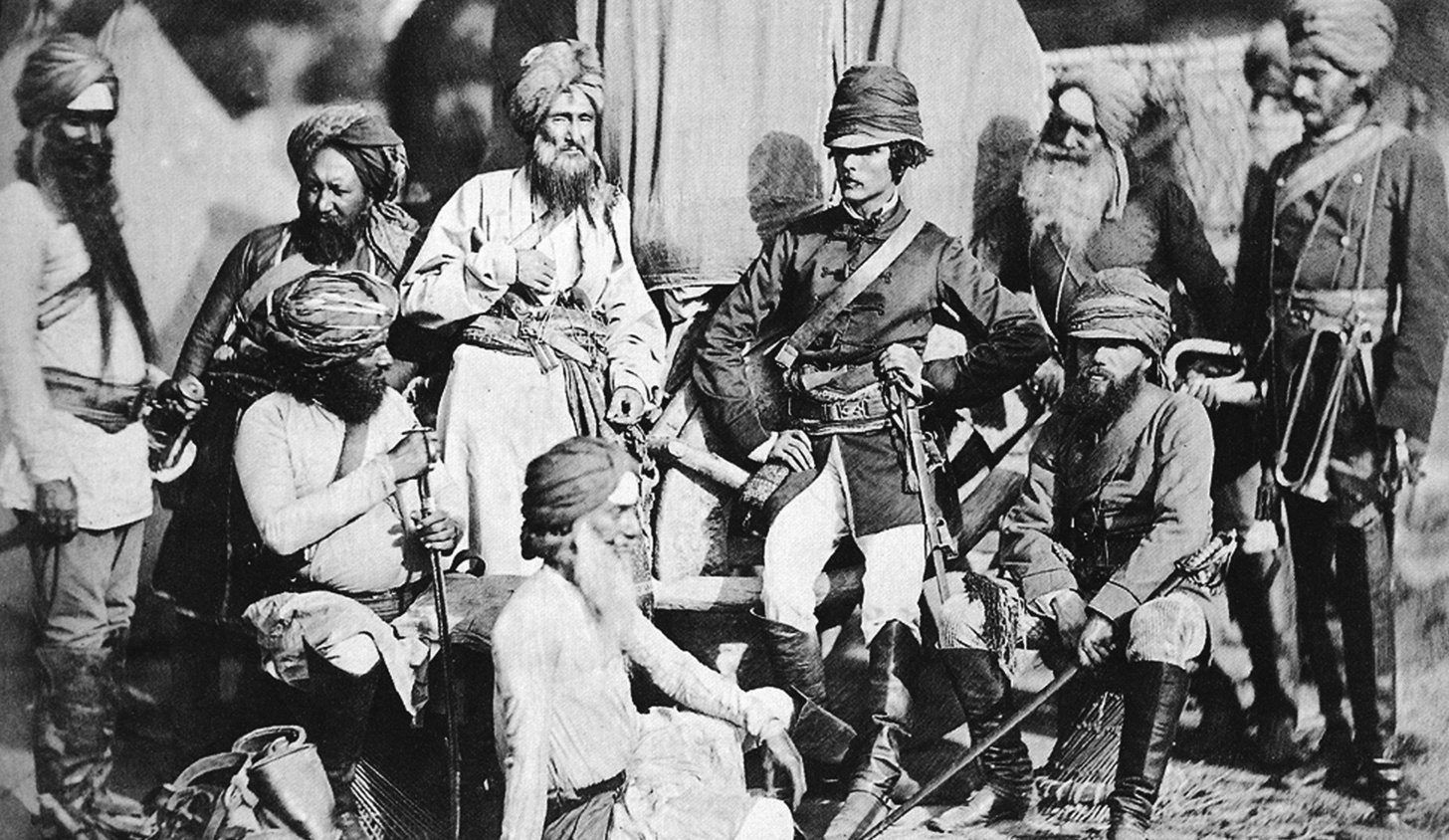
Клиффорд Генри Мечем с членами полка "Ходсонс Хорс", 1858. Фото Феличе Беато / Clifford Henry Mecham and Dr Thomas Anderson with a group of Hodson's House, 1858. Photo Felice Beato. Howard & Jane Ricketts Collection
I did not save the signatures (or maybe there were none?). But looking at their houses, I felt some of their importance and commonality. Yes, and the officer seemed not so relaxed reveler.
His posture, the abundance of small and important details around persistently evoked some kind of association. Most likely with an old engraving or book illustration. From childhood, pictures surfaced – to “The Three Musketeers”, “The Headless Horseman”, Jules Verne of the artist Kuskov, about whose magical appearance in my life I once wrote. Having unsuccessfully searched the web for illustrations similar to Kuskovo, I gave up this activity and turned to the frame with skeletons.
Skeletons, “The Apotheosis of War”, India… I immediately remembered the story told by the old crocodile, by Kipling, which I re-read this spring in Thailand:
“- So many dead Englishmen floated downstream that they touched each other. From Agra to Etawah and to wide waters near Allahabad, one had to lie quietly in the water; and I used to pass twenty corpses before choosing what was to my taste; most importantly, I liked that the English did not mix up jewelry, bracelets on the hands and ankles and rings, like the women living in my village. At that time, all the crocodiles of the surrounding rivers got fat, but fate wished that I got fatter than everyone else.
Rumors reached us that the English had been driven into the rivers and, by the right and left banks of the Ganges, we believed it.
In those days no one shot at us guards of the fords. All guns were taken elsewhere. Day and night, their roar was heard from afar.
…I moved upstream; near Arrach and above this place, I no longer found dead Englishmen. There was nothing in the river. Then two or three dead people in red jackets appeared, but they were not English, but Indians; soon they swam five and six side by side; from Arrach and Agra, it seemed, whole villages had gathered in the river. The dead floated up from small streams, like chumps during the rains. When the water in the river began to rise, the piles of silent bodies moved from the shallows on which they lay. The flood took them with it through the fields and through the jungle, the water dragged them by their long hair. Moving north, I heard shots at night, during the day – the sound of shod feet fording the river, as well as the noise that the wheels of loaded carts make on the sand under water. And each jet brought new dead. Finally, I became scared myself. I said, “If this happens to people, how will Megger of Megger Gaut be saved?” (Second Jungle Book, “Grave Diggers”)
This is it – about the revolt of the sepoys! The Ganges, along which the old Megger sailed, flowed through Kanpur.
Kanpur
Several hundred Englishmen who lived there at first tried to defend themselves, but the rebels persuaded them to surrender, promising to send them away in boats along the Ganges. What happened at the river is not exactly known, but a massacre broke out there and most of the captives were killed. The surviving 200 women and children were first imprisoned in the tower, but the leader of Nana Sahib ordered them to be killed in order to hide the traces of the perfect atrocity. The sepoys refused to shoot at the women, and then, on the orders of Nana Sahib, five of his bodyguards chopped them all with sabers.
“We did not want to kill them, we only wanted the British to GO! This mistake was made by madmen and non-sepoys,” the sepoy Sunni Kalara later justified.
However, searching the image for the word “Kanpur” did not return anything. Not far, to the east of Kanpur, there was another city – Lucknow.
Lucknow
The Europeans there, already knowing the history of Kanpur, decided to fight to the end.
Nearly 3,000 Englishmen and their faithful Hindus, including women and children, took refuge in the Residence – the manor of Governor Sir Henry Lawrence, standing on a hill near the city. Dozens of times more outnumbered, the Indians besieged them for more than half a year. More than half died from shelling, starvation and epidemics within the colony.
Today we were able to spend no more than an hour in Delhi without air conditioning – 45 degrees plus! They fought in the siege all summer. The first attempt at liberation ended with the fact that the detachment that had made its way to the besieged remained with them in the blockade ring, unable to break out. Soon, the commander-in-chief of the troops in India, 65-year-old Sir Campbell, himself led 4,000 people to the liberation of Lucknow. After 2 months, he managed to break through to the besieged and withdraw the survivors under cover of night from the city, leaving him to the rebels. The powerful Residence during the siege turned into ruins, standing in the middle of Lucknow to this day in the form of a museum.
Residence at Lucknow before and after the siege
The siege (as well as the history of Kanpur) was described in detail by Mark Twain:
“Six weeks after the beginning of the siege, the garrison had already lost more than half of its original number of white soldiers and about three-fifths of the original number of Indians.
But the struggle continued, no matter what. The enemy made digs, the British responded in the same way, and the posts of both took off into the air. The entire estate of the Residence was furrowed by the enemy’s underground passages. There was a constant exchange of deadly courtesies: now the British made sorties under the cover of night, now the enemy went over to the attack, trying to make a breach in the wall or climb over it; however, these attacks cost heavy losses and always ended in failure.
Women are accustomed to all the horrors of war: to the groans, the wounded, the sight of blood and death. (“On the equator. Chapter XXII. Terrible days of the uprising”)
Googled “Lucknow” and immediately got a picture with skeletons! It was called “The Interior of the Secundra Bagh after the destruction of 2,000 rebels by the 93rd Mountain and 4th Punjab Regiments. Sir Campbell Collin’s first attack in November 1857, Lucknow.”
The battles for the Residence and the desperate breakthrough were extremely bloody. But the caption to the picture does not mention the Residence at all, but another place. What is Secundra Bagh?
Secundra Bagkh
“A vast garden fenced with a stone fence with towers at the corners” was in the way of Campbell’s detachment, making its way to the besieged Residence. The sepoys who filled it “met the British with heavy musket fire from shelters. Falling under bullets, they managed to turn the gun and make a hole in the wall. the basis of the rescue squad. Of the 2,000 sepoys who took refuge in Sekundra Bagh, not one survived. “
“The last eight or ten miles of the way, Sir Colin Campbell walked through a sea of blood. The bayonet served as the main weapon, the fight was not for life, but for death. The path was blocked by strong stone buildings, each of which was a small but well-fortified fort, defended by hundreds Indians Neither side was willing to ask or grant mercy.
… At that time there were almost no trees on the plain, and the defenders of the Residence could observe every step, every victory of Campbell’s soldiers; their progress could be seen from the clouds of powder smoke and heard from the rumble of guns.” (Mark Twain, “On the Equator”)
Finished movie, right? Panorama with approaching smoke…
The picture was taken almost a year after the battle, and the uncleaned bodies managed to turn into skeletons…

Bird's eye view of Lucknow and the country toward Cawnpore by James S. Virtue and Co., London, c.1860.
The apocalyptic plot became finally clear. It remained to find out something about the photographer, because the name of the author is known.
Felice Beato
– also turned out to be a celebrity. An Italian living in England, from the generation of the first photography professionals, began working as early as the 1840s. Not only that, Felice was the world’s first war photographer! True, battle scenes were not yet given to him with the technology of that time: a camera that shot on 10×12-inch plates required a very long shutter speed. But there were a lot of pictures of the consequences of battles, military camps, portraits. He later filmed the Second Opium War in China and other campaigns. And he rushed to the war in India straight from … Sevastopol, where he filmed his fall during the Crimean War! Later in Japan, he made a famous series of portraits of samurai and geishas and amazing panoramas of city views.
By the way, as for the skeletons, contemporaries suspected that Beato deliberately dug up the buried bodies to create a more dramatic picture. That would be a “staging”, not like today’s!
Photos of Felice Beato from different wars
Suddenly, among the photographs of Beato, my second picture was also found – with the same brave officer. Moreover, it was also made in Lucknow, in the battles for which…
Hodson’s Horse
– Lieutenant William Hodson’s light cavalry regiment. This is his officers and Sikh soldiers posing for Beato in the picture. William Stephen Raikes Hodson turned out to be an extraordinary figure. “A tall man with yellow hair” (though I was struck by a bald spot), a graduate of Cambridge, a linguist, who immediately took up the study of Hindi and Persian upon his arrival in India. His brother sent him heavy suitcases with classical literature, and after his death he published a collection of his letters. At the same time, Hodson was known as a fearless warrior, the best swordsman in the Indian army, shooter and rider, able to sleep in the saddle. Composure in battle and a sharp look were combined in him with an unrestrained disposition and “a tendency to self-will.” When an “irregular” cavalry corps was organized 10 years before the uprising, he was first responsible for its equipment and weapons. And the first thing he did was to compose a new light and inconspicuous form, for the first time in the world using “khaki” colors in the army. At the beginning of the uprising, he rode for 72 hours 152 miles through the lands occupied by the sepoys to deliver a dispatch about the riots to headquarters.
But Hodson is best known for interrupting the Mughal dynasty.
During the fighting for Delhi, he rode with 50 soldiers to the rebel camp outside the city and demanded surrender. Before the eyes of 6,000 warriors, old Bahadur Shah Zafar, the last of the Great Mughals, handed over to him the symbolic sword “Nadir Shah” as a sign of humility, then the rest disarmed. But his three sons refused to submit to the will of their father and the English. Hodson first arrested the princes, but as the procession entered Delhi, outraged residents began to gather around. Hodson immediately shot all three in cold blood, taking a carbine from one of the soldiers. In England, he is still revered as a national hero. In India, they are remembered for their extreme cruelty in the suppression of the rebellion. “I am not cruel,” Hodson wrote to his sister, “but I confess that I really enjoyed the opportunity to rid the earth of these unfortunates.”
Bahadur Shah Zafar
was a direct descendant of Genghis Khan. In his youth, he dressed like a simple dervish, and having taken the throne at 60, he could only watch the final decline of the empire. But he himself turned out to be perhaps the most talented and handsome of the entire dynasty. A Sufi philosopher, calligrapher and garden designer, patron of the art of miniature, he was best known as the author of mystical Sufi ghazals. He wrote in Urdu, Persian, Braj Bhasa and Punjabi. Being a Muslim, he also patronized Hindu subjects and celebrated many Hindu holidays in the palace.
When the uprising reached the capital, the 83-year-old ruler at first refused to lead it and tried to stop the massacre of the British in Delhi, but later realized that he had no other choice. And he was proclaimed King of all India by the rebels. Realizing the doom of the uprising, he nonetheless appointed his sons to command the army. In addition to the three Hodson killed, many of his children and family members were hanged. When they showed him the heads of the murdered sons, he only said: “Praise be to Allah that the descendants of Tamerlane always go ahead of their fathers.” After his capture, he was kept in the Red Fort of Delhi and Europeans were taken to his cell on excursions. Hodson’s wife was also there, leaving a diary entry. Then he was sent into exile and died in Rangoon after 4 years.
Shah Zafar was also seen in captivity by correspondent William Howard Russell, considered the father of military journalism:
“In a dirty, dark cell sat a frail old man, accused by the British of being the main mastermind behind the grand mutiny – the most serious armed resistance to Western imperialism that has ever taken place in the world. I saw the dull look of extreme old age above the drooping lip of a toothless mouth. Absolutely silent he he sat on the floor day and night, staring at the ground and completely oblivious to the conditions he was placed in. Some heard how at night he read some verses that he tried to write down on the wall with the charred end of a stick … “

Бахадур II Шах в мае 1858 года, сразу после суда и перед отъездом в изгнание в Бирму. Фотография сделана в Дели двумя фотографами: профессиональным фотографом Чарльзом Шепардом, основавшим в Индии фотостудию Shepherd & Robertson, и военным любителем фотографии Робертом Кристофером Титлером. Коллекция Британской библиотеки.
Bahadur Shah awaits deportation to Burma after trial
It would seem that the second picture is “deciphered”. It was made immediately after the final liberation of Lucknow from the rebels, even the names of the characters were found. However, Hodson himself was not among them. He just died in battle. As stated in the report, “from being fired by mistake.” According to another version, in the liberated Lucknow, he was shot at point-blank range by one of the rebels who remained there and were hiding. Who knows?
And the akimbo officer in the frame is Lieutenant Henry Mechem.
Clifford Henry Mechem
(what a familiar name – remember the failed lover of the queen-Belokhvostikova in Strib’s “Glass of Water”?) was no less an artistic person. He played the flute, wrote poetry and was an excellent draftsman who did not leave pencils even during the war. Nothing is known about his military exploits. But the memories of saving a drowning friend from the bottom of the river were preserved. He also published an album of lithographs based on his drawings made during that memorable campaign. They now often illustrate the story of the siege and liberation of Lucknow. In the picture he is 27 years old – the age of Lermontov. But he died a little later – at 34, having contracted hepatitis.
Lieutenant Henry Sword. Photo by Felice Beato. Drawings by Henry Mechem from the album of his lithographs “The Siege of Lucknow”
On the back of one of the drawings, Mechem wrote: “To my future readers with the wish of many returns in this happy season!”
PS. I learned a lot about the characters in this story, and I was left with only one question:
Why did such bright and gifted people kill each other with such implacable cruelty that even crocodiles were horrified?!
Links
Detailed description of the siege and liberation of Lucknow
Beato’s Photos from Lucknow
Indian Beato’s photos from the UK National archive
“Sevastopol album of Robertson and Beato”, published in Russia in 1900-1904 гг
Clifford Henry Mecham
Description of the assault on Sekundra Bagkh with illustrations
